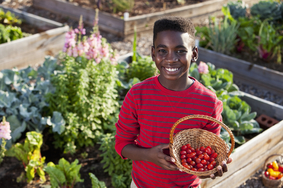|
Having trouble viewing this email? View it as a Web page.

|
|
|
Fresh from the Field is a weekly album showcasing transformative impacts made by grantees supported by the National Institute of Food and Agriculture.
Dec. 7, 2017
|
|
Success Stories

Research Details Genetic Resistance to Soybean
Sudden Death
Soybean
is one of the world's most valuable oil-seed crops and is a major source of
protein for animal feed and human diets. In 2010, the total U.S. soybean crop
value was over $38.9 billion, but may well have been 14.4% higher if not for
diseases like soybean sudden death syndrome (SDS).
Now,
a researcher from Iowa State University is charting mechanisms – one gene at a
time -- that could lead to soybean varieties that are resistant to SDS. With
support from a $5.3 million NIFA grant, Madan Bhattacharyya has found genes in
the Arabidopsis plant that could act in concert to help soybeans fight off the
disease.
Soybean
plants that have had the gene inserted have shown SDS resistance in two years under
field conditions.
NIFA supports this project through an Agriculture and Food Research Initiative
grant.
Read the full story in Iowa Ag Connection. USDA photo.
|

Clemson
Releases New Soybean Cultivar that Extends Planting Season and Growing Region
The
soybean planting season and growing region have been extended thanks to
researchers at Clemson University’s Pee Dee Research and Education Center. The
Agustina soybean cultivar possesses the long juvenile (LJ) trait, which gives it
the ability to produce high yields even when days get shorter and daylight
hours are fewer. The LJ trait also allows the Agustina soybean to grow in
regions that are not suited for most existing soybean cultivars. Agustina also is
resistant to soybean cyst nematodes, the primary pest of soybeans.
NIFA
supports the research with Hatch funding.
Read the full article in the Clemson Newsstand.
Photo courtesy of Clemson University Public Service and Agriculture.
|
News Coverage

Predatory Insect May Help With Whitefly Control
Scientists
at the University of Florida have found an insect predator that may help
greenhouse tomato growers manage populations of the sweetpotato whitefly when
used as a piece of an integrated pest management system. Sweetpotato whiteflies
attack a range of plants, including sweetpotato, squash, tomato, and poinsettia.
The fly transmits Tomato Yellow Leaf Curl virus, which cause plants to be
stunted and unproductive.
After scientists introduced whitefly predator Dicyphus
Hesperus into a greenhouse environment, only seven whitefly eggs and 14
nymphs per leaf were present, compared with untreated plants that had 151 eggs
and 229 nymphs per leaf.
NIFA
supported the program through an Integrated Pest Management Enhancement grant.
Read the full article in IPM in the South. Photo by Hugh Smith,
University of Florida.
|
The Library

Longitudinal Perspectives of Faculty and
Students on Benefits and Barriers to Transdisciplinary Graduate Education:
Program Assessment and Institutional Recommendations
Addressing
complex societal problems, such as childhood obesity, requires
transdisciplinary approaches to reach effective solutions. With NIFA support,
researchers at University of Illinois created the Illinois Transdisciplinary
Obesity Prevention Program (I-TOPP) to establish a new transdisciplinary
PhD/MPH degree program focused on childhood obesity prevention. I-TOPP
published its first program evaluation paper.
The study assessed benefits and
barriers of a transdisciplinary approach to doctoral education from the
perspectives of students working towards a joint PhD/MPH degree and their
faculty advisors. Results show that benefits across five years included greater
collaboration and networking, enhanced guidance and support, broadened ways of
thinking, and expanded opportunities. In addition, I-TOPP students’
publications were cited five times more often than other students in similar
fields.
Read
the article in Palgrave Communications.
iStock photo.
|
Video
 State’s Food Pantries Enjoy Fresh Food Grown at
UNH Farms and Facilities
New
Hampshire residents who rely on the state’s food pantries have been enjoying
fresh food donated by the NH Agricultural Experiment Station at the University
of New Hampshire (UNH), including tilapia and lettuce produced in sophisticated
aquaponics systems and squash and other vegetables grown at university farms.
Researchers
at UNH have designed an aquaponics agriculture system to sustainably grow fish
and fresh produce. The systems are designed for use in urban areas where fresh
foods may not be readily available. So far this year, UNH has donated almost
5,000 heads of lettuce, 44 boxes of tomatoes, 28 boxes of peppers, 400 pounds
of squash, and 1,100 pounds of fish.
NIFA
supports this project with Hatch funding.
Watch the video on Facebook and hear researcher
Tom Guerdat describe the aquaponics project.
|
Tweet of the Week
#NIFAIMPACTS
|
|

NIFA’s mission is to invest in and advance agricultural research, education, and extension that solve societal challenges. NIFA’s investments in transformative science directly support the long-term prosperity and global preeminence of U.S. agriculture. To learn more about NIFA’s impact on agricultural sciences, visit www.nifa.usda.gov/Impacts, sign up for email updates or follow us on Twitter @USDA_NIFA, #NIFAImpacts.
Editor: Scott Elliott
USDA is an equal opportunity lender, provider, and employer.
|
|